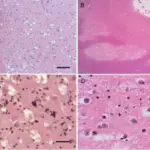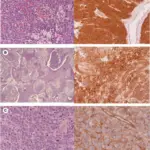
LIN28A immunohistochemistry in pediatric malignant CNS tumors. Microscopic appearance of ETMR composed of clusters of multilayered rosettes embedded in abundant neuropil (initially diagnosed as ETANTR) (a). Intense LIN28A expression in poorly differentiated areas containing rosettes and the absence of expression in neuropil of tumor (b). Microscopic appearance of ETMR composed of numerous rosettes with clusters of small poorly differentiated cells (initially diagnosed as ependymoblastoma) (c). Strong and diffuse LIN28 expression in all parts of the tumor (d). AT/RT. Focal LIN28A expression in single collections of tumor cells (e). Anaplastic ependymoma. Immunonegativity for LIN28A in tumor region with numerous ependymal rosettes (f). LIN28A immunoreactivity is a potent diagnostic marker of embryonal tumor with multilayered rosettes (ETMR).
Korshunov A, Ryzhova M, Jones DT, Northcott PA, van Sluis P, Volckmann R, Koster J, Versteeg R, Cowdrey C, Perry A, Picard D, Rosenblum M, Giangaspero F, Aronica E, Schüller U, Hasselblatt M, Collins VP, von Deimling A, Lichter P, Huang A, Pfister SM, Kool M - Acta neuropathologica (2012). Not Altered. CC.
Poorly differentiated neoplasms of the central nervous system are tumors of the CNS which are dangerous, aggressive, fatal and have a high metastatic potential.
Poorly differentiated neoplasms of the central nervous system include:
- Medulloblastoma
- Atypical teratoid tumor
- Atypical rhabdoid tumor



